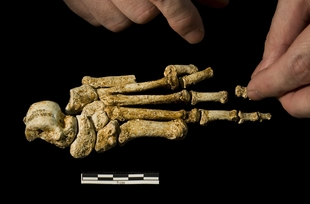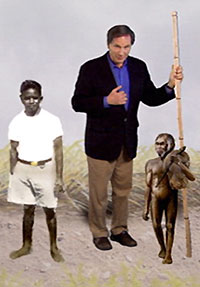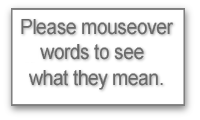Science news in brief
10-May-2009
The week in Real Science

The research below, chosen from hundreds of papers published this week, ranges from hobbits to neutron stars, from the two cultures to the structure of turbulence and the day the universe froze. Take a look:
5 May 2009 No evidence for effectiveness of swine flu interventions
"Panic has ensued in some regions: the culling of hundreds of thousands of pigs has been ordered in Egypt; pork trade has been restricted; facemasks have been widely distributed; airports are using thermal-based scanners to screen passengers. These measures have little, or no, evidence for their implementation."
6 May 2009 Hobbit had flat feet
An international team has just published the first scientific analysis of the foot of Homo floresiensis, the fossil found in Indonesia in 2003 and popularly referred to as the “Hobbit.”
5 May 2009 Rigid structure at heart of turbulence
Mathematical engineers have discovered for the first time a rigid structure in the centre of turbulence, raising hopes that its chaotic motion might one day be controlled.

5 May 2009 Is Newton wrong in the large?
Cosmologists turn more and more to dark matter to explain the inexplicable, yet no direct proof of its existence has been found. Even if it does exist, it will be unable to reconcile all the current discrepancies between measurements and theory. Some physicists are now questioning the existence of dark matter. Alternative theories of gravitation have been developed. “Maybe Newton was wrong”, says Pavel Kroupa of Bonn University´s Argelander-Institut für Astronomie (AIfA).
6 May 2009 Star crust 10 billion times stronger than steel
The crusts of neutron stars are 10 billion times stronger than steel or any other of the earth's strongest metal alloys, according to new research from Indiana University.
7 May 2009 Star Trek warp speed
Moviegoers are about to see once more the Starship Enterprise boldy going across the galaxy faster than the speed of light. Can this ever become reality? Two Baylor University physicists have an idea that can turn traveling at the speed of light from science fiction to science, they say, without break any laws of physics.

7 May 2009 Two cultures turns 50
Half a century ago today, physicist and author Charles Percy Snow (1905—1980) delivered the annual Rede Lecture at the University of Cambridge.Its title — “The Two Cultures” — referred to a gulf Snow detected between “literary intellectuals” and “natural scientists”. The talk was published in Encounter in June and July 1959, and then as a book.
8 May 2009 Day the universe froze
Imagine a time when the entire universe froze. According to a new model for dark energy, that is essentially what happened about 11.5 billion years ago, when the universe was a quarter of the size it is today.
8 May 2009 DOE budget lifts renewables, cuts nuclear and coal
The Department of Energy's $26.4 billion budget request for year 2010 proposes cutting funding for nuclear and fossil power and increasing funding for energy efficiency and renewable energy.
9 May 20089 Fresh perspective on the two cultures
In addition to the well-publicized map of science released last week by Los Alamos National Laboratory researchers, the group also created a cross-validating map as part of the same study, with nodes divided in half, categorically based on journals’ top-level classification, as either natural sciences (blue) or humanities and social sciences (yellow).
Education resources, classroom activities, cool stuff
Two cultures
Maps of sciences and social sciences
Hobbit
See the skull and skeleton, including the feet (video)
Hobbit's big feet offer clues to its origin (audio)
Transcript of 10 May 2009 podcast
Two cultures, two humans
With no big science story this week, interest focused on the 50th anniversary of CP Snow's Two cultures lecture.
It's a way of looking at the world of ideas that took a firm hold right from the start. And it's as relevant today as when the science-educated novelist first pointed out the wilfully woeful ignorance of the literary establishment, those self-appointed intellectuals who dominated academic discourse but despised science.
I'd like to talk about this now since it's topical – if something that happened 50 years ago can sensibly be called topical. But although I've read endless comment on the two cultures, I haven't yet read Snow's lecture or the book that grew out of it.
Once in a while I try not to talk about topics I know nothing about, so I'll reluctantly save any comment on the two cultures until I've read Snow's book, which I ordered this week.
So what else have we got? Well there are hobbits, turbulence, swine flu again, lots of astronomy and cosmology, extra funding for renewable energy and maps of science and social science – the last of which also has a wee flavour of the two cultures from an interesting new angle.
Little people
Let's start with the hobbits, the popular name for the race of little people whose fossils were found in 2003 on the island of Flores in Indonesia. Just how little they were – half our height and a fifth of our weight – can be seen from the startling photograph on the Nova website, the second link in our resources section, as well as from the video of the bones which is our first link.
Nova also has a bunch of other great resources – a video, an interview with evolutionary biologist Jared Diamond and an Ask the Expert session with Bert Roberts from the University of Wollongong team that excavated and analysed the remains of the little people.
This latest research on the shape of the Homo floriensis feet provides more evidence that were not like us. "It's a jaw-dropping foot," says anthropologist Daniel Lieberman. "It's one of a series of pieces of evidence that seal the deal for me." The "deal" being that these people were human but a different species from us.
Big feet
Unlike ours their feet were not designed for running well. Although large for their body size the feet had no arches. The hobbits in fact had flat feet.
Not conclusive, of course, since so do plenty of Homo sapiens, including I learned from Radio 4's News Quiz, Sylvester Stallone – which is why Rambo in real life never fought in the Vietnam war. But one more piece of evidence for the by now pretty convincing different species hypothesis.
So what are the big questions about these hobbits? There are several, but first let me point out the astonishing implications of their discovery. These people are human but they belong to a different species from us.
Every human alive on Earth today that we know of belongs to just one species. This means that you and I can have healthy babies even if I'm a Zulu from South Africa and you're an Eskimo from Alaska. Or I'm a guy from Cumnock and you're a girl from Auchinleck. It happens occasionally.
The Hobbits are not like us and having babies with them would have been difficult if not impossible. We'll come to that in a minute. But this different species of human was sharing the Earth with us until just 11,000 years ago – and maybe later.
So that now makes three different species of human that we know were living on Earth until modern times – Neanderthals, Hobbits and us.
Not from the Shire
Incidentally we really shouldn't be calling them hobbits, because words are powerful. They create images in the mind. They lead us by the nose and shape our thinking.
When I hear the word hobbit I see Merry and Pippin, cheeky, perky and appealing, being carried along in Treebread's branches, smoking pipes, getting pissed, telling jokes, and being brave. It's unlikely Homo floriensis did any of these things – except the brave bit.
Because Homo floriensis probably hunted Komodo dragons, which are up there in my top five list of beasts I don't want to be stuck in a lift with (the other four, if you want to know, are slaters, big spiders, my ex-wife and Noel Edmonds).
Komodo dragons are bad enough nowadays, but the Flores mob were extra large, weighing in at 200 kilograms each. And the thing about Komodo dragons even today is that their mouths are home to deadly germs that make swine flu look like the friendly bacteria in a bottle they sell down the supermarket.
So if a dragon bites you but you escape you then die an agonising death days later from infection. Mind you it still sounds better than the Noel Edmonds option.
Where did they go?
So the big question is what happened to tough little characters that could work together to take on these ferocious beasts? Did they die out through lack of resources or natural disaster? Were they wiped out by us? Did they interbreed with Homo sapiens in the early days, before the two species grew too far apart? Might they be still around somewhere, hidden away in remote caves and woodlands?
On the last point nobody knows for sure, says Bert Roberts, but it's highly unlikely. "My heart says yes but my head says no, because the chances must surely be vanishingly small."
Diamond and Roberts agree on that. Where they disagree is on the question of what finished the hobbits off. Homo sapiens is a nasty piece of work, Diamond says, that wipes out most large animals it meets. Roberts' money is on the little guy.
"They had been living on the island for millennia and would have known the lay of the land intimately. They had brains that could probably carry out advanced cognitive functions. And they were slaying dragons and half-ton elephants.
"Then we, Homo sapiens, land on the shore, unacquainted with the new land or with the habits and capabilities of these half-size hunters. Who would you back in a fight to the death?"
Dangerous liaisons
So much for war. What about sex? Did Homo sapiens interbreed with Homo floriensis?
"My bet is we did not," says Diamond, "and here's why. Although they were small, they would have been tough, nasty characters."
He then tells a story about a man attacked by chimpanzees – another cute-seeming relative of ours that can be every bit as vicious as we can. They pulled off his nose and attacked his eyes. They chewed off his fingers. They chewed out his buttocks.
"What do I think would have happened if some full-sized male sapiens had presented his private parts for having sex with this 30-pound pygmy?" Diamond asks.
"I would not have given much for the future of the private parts of that male sapiens."
That's all for this week from Real Science.
Thanks for listening.
Keep thinking.
And keep away from hobbits – they're not as cute as you thought they were.
More help with words
inferior, irregular, vortices, unpredictable, evolution, origin, breed, fertile, tentative, prediction, experiment


